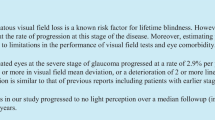Abstract
The efficacy of glaucoma therapy in preventing progression of glaucomatous field loss was investigated in a retrospective study. Hundred eyes with glaucomatous field defects of 71 patients were enrolled in the study. The mean observation period was 3.8 years. The evaluation of potential visual field changes was made with the biostatistical program Delta of the Octopus computerized perimeter. All field examinations were done with the same automated perimeter (Octopus, model 201). In 19% of the eyes adequate medical or surgical therapy failed to arrest the disease process. Improvement or deterioration of the whole field can be simulated by changes of the pupillary diameter, whereas deterioration in the pathologic area only is highly specific for progression of the glaucomatous process.
Similar content being viewed by others
References
Chandler PA (1960) Longterm results in glaucoma therapy. Amer J Ophthal 49: 221- 246
Fankhauser F, Bebie H (1981) Handbook to Program Delta. Schlieren, Interzeag
Gloor B, Schmied V and Fässler A (1980a) Changes of glaucomatous field defects. Degree of accuracy of measurements with the automatic perimeter Octopus. Int Ophthal 3: 5–10
Gloor B, Schmied V and Fässler A (1980b) Glaukomgesichtsfelder-Analyse von Octopusverlaufsbeobachtungen mit einem statistischen Programm. Klin Mbl Augenheilk 117:423–436
Gloor B, Schmied V and Fässler A (1981) Changes of glaucomatous field defects. Analysis of Octopus fields with program Delta. Docum Ophthal Proc Ser 26: 11–15
Gloor B, Stürmer J and Vökt B (1984) Was hat die automatisierte Perimetrie mit dem Octopus für neue Kenntnisse über glaukomatöse Gesichtsfeldveränderungen gebracht? Klin Mbl Augenheilk 184: 294–253
Gramer E, Pröll M and Krieglstein GK (1980) Die Reproduzierbarkeit zentraler Gesichtsfeldbefunde bei der kinetischen und der computergesteuerten statischen Perimetrie. Klin Mbl Augenheilk 176: 374
Krieglstein GK, Schrems W, Gramer E and Leydhecker W (1981) Detectability of early glaucomatous field defects. A controlled comparison of Goldmann versus Octopus perimetry. Docum Ophthal Proc Ser 26: 19–24
Krieglstein GK, Helmbold C and Leydhecker W (1982) Zur Prognose des chronischen Glaukoms. Eine epikritische Studie. Z Prakt Augenheilk 3:17–24
Leydhecker W (1960) Die Prognose des Glaucoma simplex bei Behandlung mit Miotika im Frühstadium. Klin Mbl Aubenheilk 137: 606–612
Niesel P and Flammer J (1980) Correlation between intraocular pressure visual field and visual acuity, based on 11 years of observations of treated chronic glaucomas. Int Ophthal 3: 31–35
Quigley, H and Maumenee AE (1979) Longterm follow-up of treated open-angle glaucoma. Amer J Ophthal 87: 519–525
Author information
Authors and Affiliations
Rights and permissions
About this article
Cite this article
De Natale, R., Glaab-Schrems, E. & Krieglstein, G.K. The prognosis of glaucoma investigated with computerized perimetry. Doc Ophthalmol 58, 385–392 (1984). https://doi.org/10.1007/BF00679801
Issue Date:
DOI: https://doi.org/10.1007/BF00679801




